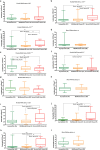Dynamic and features of SARS-CoV-2 infection in Gabon
- PMID: 33958601
- PMCID: PMC8102484
- DOI: 10.1038/s41598-021-87043-y
Dynamic and features of SARS-CoV-2 infection in Gabon
Abstract
In a context where SARS-CoV-2 population-wide testing is implemented, clinical features and antibody response in those infected have never been documented in Africa. Yet, the information provided by analyzing data from population-wide testing is critical to understand the infection dynamics and devise control strategies. We described clinical features and assessed antibody response in people screened for SARS-CoV-2 infection. We analyzed data from a cohort of 3464 people that we molecularly screened for SARS-CoV-2 infection in our routine activity. We recorded people SARS-CoV-2 diagnosis, age, gender, blood types, white blood cells (WBC), symptoms, chronic disease status and time to SARS-CoV-2 RT-PCR conversion from positive to negative. We calculated the age-based distribution of SARS-CoV-2 infection, analyzed the proportion and the spectrum of COVID-19 severity. Furthermore, in a nested sub-study, we screened 83 COVID-19 patients and 319 contact-cases for anti-SARS-CoV-2 antibodies. Males and females accounted for respectively 51% and 49% of people screened. The studied population median and mean age were both 39 years. 592 out of 3464 people (17.2%) were diagnosed with SARS-CoV-2 infection with males and females representing, respectively, 53% and 47%. The median and mean ages of SARS-CoV-2 infected subjects were 37 and 38 years respectively. The lowest rate of infection (8%) was observed in the elderly (aged > 60). The rate of SARS-Cov-2 infection in both young (18-35 years old) and middle-aged adults (36-60 years old) was around 20%. The analysis of SARS-CoV-2 infection age distribution showed that middle-aged adults accounted for 54.7% of SARS-CoV-2 positive persons, followed respectively by young adults (33.7%), children (7.7%) and elderly (3.8%). 68% (N = 402) of SARS-CoV-2 infected persons were asymptomatic, 26.3% (N = 156) had influenza-like symptoms, 2.7% (N = 16) had influenza-like symptoms associated with anosmia and ageusia, 2% (N = 11) had dyspnea and 1% (N = 7) had respiratory failure, which resulted in death. Data also showed that 12% of SARS-CoV-2 infected subjects, had chronic diseases. Hypertension, diabetes, and asthma were the top concurrent chronic diseases representing respectively 58%, 25% and 12% of recorded chronic diseases. Half of SARS-CoV-2 RT-PCR positive patients were cured within 14 days following the initiation of the anti-COVID-19 treatment protocol. 78.3% of COVID-19 patients and 55% of SARS-CoV-2 RT-PCR confirmed negative contact-cases were positive for anti-SARS-CoV-2 antibodies. Patients with severe-to-critical illness have higher leukocytes, higher neutrophils and lower lymphocyte counts contrarily to asymptomatic patients and patients with mild-to-moderate illness. Neutrophilic leukopenia was more prevalent in asymptomatic patients and patients with mild-to-moderate disease for 4 weeks after diagnosis (27.1-42.1%). In Patients with severe-to-critical illness, neutrophilic leukocytosis or neutrophilia (35.6-50%) and lymphocytopenia (20-40%) were more frequent. More than 60% of participants were blood type O. It is also important to note that infection rate was slightly higher among A and B blood types compared with type O. In this African setting, young and middle-aged adults are most likely driving community transmission of COVID-19. The rate of critical disease is relatively low. The high rate of anti-SARS-CoV-2 antibodies observed in SARS-CoV-2 RT-PCR negative contact cases suggests that subclinical infection may have been overlooked in our setting.
Conflict of interest statement
The authors declare no competing interests.
Figures





Similar articles
-
Antibody response using six different serological assays in a completely PCR-tested community after a coronavirus disease 2019 outbreak-the CoNAN study.Clin Microbiol Infect. 2021 Mar;27(3):470.e1-470.e9. doi: 10.1016/j.cmi.2020.11.009. Epub 2020 Nov 20. Clin Microbiol Infect. 2021. PMID: 33221432 Free PMC article.
-
Characteristics of Anti-SARS-CoV-2 Antibodies in Recovered COVID-19 Subjects.Viruses. 2021 Apr 16;13(4):697. doi: 10.3390/v13040697. Viruses. 2021. PMID: 33923828 Free PMC article.
-
The seroprevalence of SARS-CoV-2 in a rural southwest community.J Osteopath Med. 2021 Feb 1;121(2):199-210. doi: 10.1515/jom-2020-0287. J Osteopath Med. 2021. PMID: 33567087
-
Co-infection of SARS-COV-2 and Influenza A Virus: A Case Series and Fast Review.Curr Med Sci. 2021 Feb;41(1):51-57. doi: 10.1007/s11596-021-2317-2. Epub 2021 Feb 13. Curr Med Sci. 2021. PMID: 33582905 Free PMC article. Review.
-
COVID-19 infection in children with blood cancer: A systematic review.Ann Hematol. 2025 Feb;104(2):1203-1230. doi: 10.1007/s00277-024-06057-4. Epub 2024 Nov 5. Ann Hematol. 2025. PMID: 39496811 Free PMC article.
Cited by
-
Biochemical and hematological factors associated with COVID-19 severity among Gabonese patients: A retrospective cohort study.Front Cell Infect Microbiol. 2022 Dec 23;12:975712. doi: 10.3389/fcimb.2022.975712. eCollection 2022. Front Cell Infect Microbiol. 2022. PMID: 36619758 Free PMC article.
-
Community SARS-CoV-2 seroprevalence before and after the second wave of SARS-CoV-2 infection in Harare, Zimbabwe.EClinicalMedicine. 2021 Nov;41:101172. doi: 10.1016/j.eclinm.2021.101172. Epub 2021 Oct 24. EClinicalMedicine. 2021. PMID: 34723165 Free PMC article.
-
Clinical features and effectiveness of Chinese medicine in patients with COVID-19 from overseas: A retrospective study in Xiamen, China.Front Public Health. 2022 Oct 24;10:1038017. doi: 10.3389/fpubh.2022.1038017. eCollection 2022. Front Public Health. 2022. PMID: 36353282 Free PMC article.
-
Asymptomatic viruses detectable in saliva in the first year of life: a narrative review.Pediatr Res. 2024 Jan;95(2):508-531. doi: 10.1038/s41390-023-02952-0. Epub 2023 Dec 22. Pediatr Res. 2024. PMID: 38135726
-
Epidemiological, clinical, therapeutic features and predictors of death among COVID-19 patients hospitalized in Parakou: a cross-sectional study in Northern Benin.BMC Infect Dis. 2023 Jul 20;23(1):484. doi: 10.1186/s12879-023-08445-z. BMC Infect Dis. 2023. PMID: 37474897 Free PMC article.
References
MeSH terms
Substances
LinkOut - more resources
Full Text Sources
Other Literature Sources
Medical
Miscellaneous

